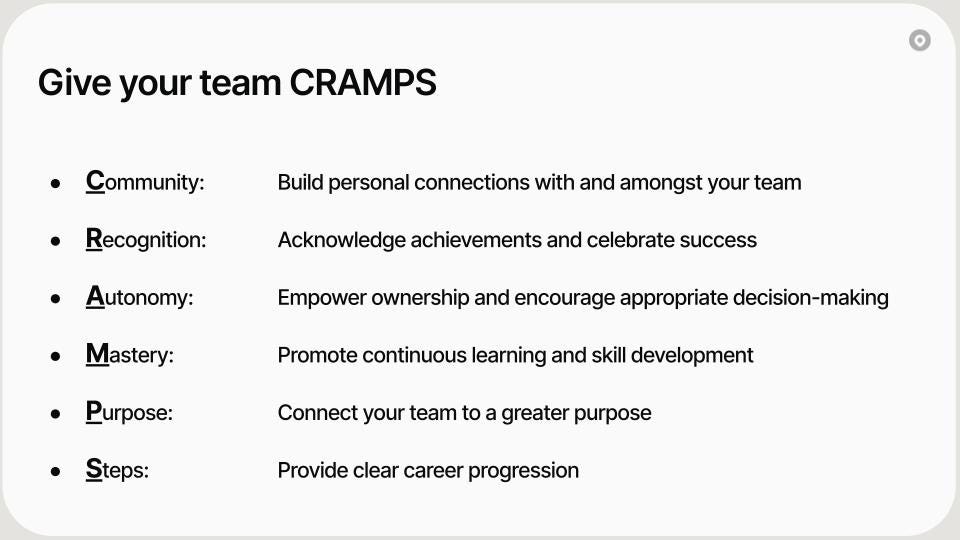Frontline Revenue Leadership Framework
A 7-pillar system to predictably scale revenue leadership teams
In my opinion, the frontline manager is the most critical role in a revenue team. You can give a group of OK reps to a great manager and that team will be very good to great. Those reps will consistently improve, give top effort and be a positive influence on the organization.
Conversely, you can give a group of great reps to an OK manager and that team will be only OK or a disaster. Those reps won’t really get better, their effort will be inconsistent and they’ll consistently be a distraction and negative influence on people around them. The best people will leave because great people can’t stand mediocre leadership.
So what’s the difference between OK and great frontline managers? A lot of the time, it’s just training, coaching and a framework that they can follow. Yet, for some reason, most leaders don’t offer a map to their frontline managers and just throw them into the wild to manage to the best of their abilities. Thus, the new manager continues to do what made them successful as a rep, and the two roles couldn’t be more different.
Instead, elite revenue organizations leverage a systematic approach to leadership; one that creates repeatable, predictable results across large teams. At Owner, we've grown from 5 to 100+ revenue ICs in 30 months while successfully ramping a number of first time, internally promoted managers and significantly outperforming industry averages across just about every performance metric. This growth wasn't accidental.
I’m hoping that this framework is a helpful starting point for managers to better understand their role and for leaders to provide more structure to their managers. I’ll build out the content around this framework over the next few years but you can start using it today as a baseline for a conversation around the jobs to be done in the role.
Your new frontline revenue leadership framework
Do
Coach
Hire
Build
Operate
Engage
Grow
1. Do
The ability to do the job yourself at a high level.
I don't believe in "dashboard jockey" managers who can't actually sell, implement or service the product. You need to be able to step into a customer situation and make things happen. One of the first requirements of a frontline manager is that they can do the job themselves.
You don't need to be the absolute best seller on the team (in fact, the very best reps often make poor managers), but you do need to be in the top 20% in my opinion. This establishes credibility, allows you to lead from the front, and most importantly, enables you to break down the components of good selling for your team.
Without this foundation, you'll struggle to build authentic credibility with your team or provide substantive coaching.
2. Coach
The ability to translate selling skill into someone else's success.
This is the most important pillar and the one most leaders get wrong. Coaching isn't telling. It's not reviewing a call and saying, "Next time, say X instead of Y." That approach creates minimal improvement.
Great coaching requires five essential elements:
Great coaching comes from a place of caring: You’ll never be able to coach effectively if you don’t genuinely care about your team and get fulfilment being in the service of others.
Great coaching requires focus: Bad coaching tries to fix everything at once. Great coaching identifies the single most important skill gap and works exclusively on that until mastery.
Great coaching is questions based: As Michael Bungay Stanier teaches in "The Coaching Habit," effective coaching uses questions to help the rep explore and discover. The struggle is where growth happens.
Great coaching is built around deep practice: This concept from Daniel Coyle's "The Talent Code" involves breaking skills into discrete chunks (isolation drills) and practicing them repeatedly with progressive resistance. We might do 15-20 repetitions of the same skill in a coaching session
Great coaching requires great follow-up: Coaching must account for the "forgetting curve." Without reinforcement, people forget 50% of what they learn within 24 hours and 80% within a month. Great coaches revisit key skills systematically.
Consider the difference between how professional sports teams practice versus how most sales teams operate. NFL teams don't just watch game tape, make a few comments, and then play another game. They break skills into discrete components, practice isolation drills with progressive resistance, and build muscle memory that translates to game-day performance.
3. Hire
The ability to systematically identify and secure talent.
Most hiring fails because it lacks systematic rigor. Sales attracts charismatic, high-energy people, which makes it easy to hire on "vibes" rather than substance.
We use a three-component scorecard that evaluates:
DNA (mindset, habits, intelligence, character)
Craft (selling capabilities)
Specialized knowledge (industry/product expertise)
Each interview in our process targets specific sections of this scorecard. We have predetermined questions designed to surface evidence of the traits we're seeking, and we force ourselves to grade each attribute separately to avoid the "halo effect" where charisma colors our judgment of everything else.
Systematizing your hiring process doesn't just improve your selection accuracy – it also reduces the impact of cognitive biases like affinity bias and confirmation bias that plague intuition-based hiring. I’ll write more on this soon.
4. Build
The ability to identify problems and create solutions.
In established companies, processes are already codified. In startups where I’ve spent most of my career, we're "building the plane while flying it." The Build pillar is about creating the systems, playbooks, training, and business processes that make your reps more effective and efficient.
Your ability to identify systemic issues and build solutions determines how quickly you can scale. The first part of being able to improve your system is being literate in data. You need to understand the business before you can improve it meaningfully. Once you’ve identified your areas of opportunity then you can create standardized documents for everything from discovery calls to objection handling to a great handoff to onboarding – not perfect documents at first, but something you could iterate on over time.
5. Operate
The ability to manage day-to-day business operations.
This is the nuts and bolts of running the revenue machine – your weekly rhythms, reporting cadence, pipeline reviews, and meeting structures. Most salespeople struggle here because the job rewards persuasion and relationship-building, not operational rigor.
This pillar includes:
Managing to your metrics
Running effective meetings
Creating accountability
Forecasting accurately
Systematizing communications
When I'm looking for internal promotions to management, I specifically seek out reps who show natural operational ability. You can succeed as a rep without operational rigor, but you cannot succeed as a manager without it.
6. Engage
The ability to drive engagement and purpose.
This isn't about rah-rah speeches. It's about connecting your team to purpose, recognizing their contributions, and helping them grow.
In Drive, Daniel Pink identifies three key motivators:
Autonomy: Freedom to approach work in their own way
Mastery: The satisfaction of getting better at something meaningful
Purpose: Connection to something larger than oneself
Using research from Gallup’s Q12, I’ve expanded on the AMP framework into my own approach called CRAMPS.
Great leaders create environments where these needs are met. They show team members their progress, help them see the impact of their work, and celebrate both effort and outcomes.
According to Gallup's Q12 research, feeling connected to purpose and seeing your progress are among the strongest drivers of workplace engagement – and engagement directly drives performance.
7. Grow
The ability to continuously improve yourself as a leader.
The seventh and final pillar might be the most overlooked – your personal growth as a leader. Too many revenue leaders focus all their energy on the team while neglecting their own development. This is a critical mistake.
Great revenue leaders approach their own performance like corporate athletes. They manage their physical and mental energy to sustain peak performance over long periods. As Jim Loehr and Tony Schwartz describe in "The Power of Full Engagement," energy – not time – is the fundamental currency of high performance.
This means:
Physical performance: Prioritizing sleep, exercise, and nutrition to maintain energy and mental clarity. I've maintained a 850+ day workout streak because I know my physical condition directly impacts my decision-making and leadership presence.
Mental performance: Developing your knowledge through intentional learning. I commit to reading, listening to podcasts, and attending events that stretch my thinking. The compound effect of learning means small daily investments create massive advantages over time. A meditation or mindfulness practice is essential here too.
Emotional resilience: Building the ability to maintain composure under pressure. Sales leadership is emotionally taxing – you need tools to manage stress, reframe setbacks, and maintain perspective during challenges. Again: mindfulness. If you’re a skeptic, my favourite book in this category is Search Inside Yourself and I really enjoyed their courses too.
Self-awareness: Understanding your strengths, weaknesses, and triggers. The best leaders know themselves deeply and continue to refine their approach based on feedback and reflection.
In my experience, this pillar amplifies all the others. Your ability to coach, engage, and build systems all improve dramatically when you invest in yourself. As you scale, your personal habits and mindset become even more important – they cascade through your entire organization.
Applying This Framework to Your Organization
Start by evaluating your current leadership approach against these seven pillars. Where are the gaps? Which pillar needs the most immediate attention?
Remember: you don't need to implement everything at once. As I tell the founders I advise, start with something simple – a basic coaching rhythm, a hiring scorecard, or weekly operating cadence. Document it, iterate on it, and build from there.
The real power comes from creating systems outside your own brain. Too many revenue organizations rely on the tribal knowledge of a few key individuals. By documenting your approaches across all seven pillars, you create a true Revenue Operating System – what I described at SaaStr as your "Iron Man suit" that enhances your natural abilities.
With these systems in place, you can scale your organization more predictably and with less stress. The framework has allowed Owner.com to grow rapidly while improving performance, not just maintaining it.





